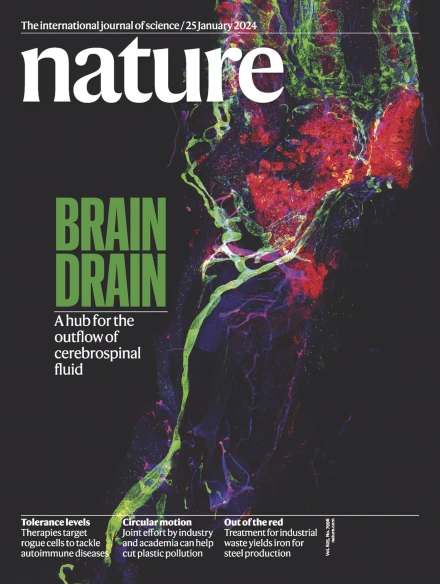Comparative connectomics of Drosophila descending and ascending neurons
IF 48.5
1区 综合性期刊
Q1 MULTIDISCIPLINARY SCIENCES
引用次数: 0
Abstract
In most complex nervous systems there is a clear anatomical separation between the nerve cord, which contains most of the final motor outputs necessary for behaviour, and the brain. In insects, the neck connective is both a physical and an information bottleneck connecting the brain and the ventral nerve cord (an analogue of the spinal cord) and comprises diverse populations of descending neurons (DNs), ascending neurons (ANs) and sensory ascending neurons, which are crucial for sensorimotor signalling and control. Here, by integrating three separate electron microscopy (EM) datasets1–4, we provide a complete connectomic description of the ANs and DNs of the Drosophila female nervous system and compare them with neurons of the male nerve cord. Proofread neuronal reconstructions are matched across hemispheres, datasets and sexes. Crucially, we also match 51% of DN cell types to light-level data5 defining specific driver lines, as well as classifying all ascending populations. We use these results to reveal the anatomical and circuit logic of neck connective neurons. We observe connected chains of DNs and ANs spanning the neck, which may subserve motor sequences. We provide a complete description of sexually dimorphic DN and AN populations, with detailed analyses of selected circuits for reproductive behaviours, including male courtship6 (DNa12; also known as aSP22) and song production7 (AN neurons from hemilineage 08B) and female ovipositor extrusion8 (DNp13). Our work provides EM-level circuit analyses that span the entire central nervous system of an adult animal. Three electron microscopy datasets are combined to provide a complete connectomic description of the neural circuitry that makes up the neck connective in Drosophila, including the descending neurons, ascending neurons and sensory ascending neurons.


果蝇下行和上行神经元的比较连接组学
在大多数复杂的神经系统中,神经索和大脑在解剖学上有明显的分离,神经索包含了行为所必需的大部分最终运动输出。在昆虫中,颈部连接既是连接大脑和腹侧神经索(类似脊髓)的物理瓶颈,也是信息瓶颈,由不同种群的下行神经元(DNs)、上行神经元(ANs)和感觉上行神经元组成,它们对感觉运动信号传导和控制至关重要。在这里,通过整合三个独立的电子显微镜(EM)数据集1,2,3,4,我们提供了果蝇雌性神经系统的ANs和dn的完整连接组描述,并将它们与雄性神经索的神经元进行比较。校对的神经元重建在大脑半球、数据集和性别之间进行匹配。至关重要的是,我们还将51%的DN细胞类型与定义特定驱动系的轻型数据5相匹配,并对所有上升种群进行分类。我们利用这些结果揭示颈部结缔组织神经元的解剖和电路逻辑。我们观察到跨越颈部的连接的dn和an链,它们可能服务于运动序列。我们提供了性别二态的DN和AN种群的完整描述,并详细分析了生殖行为的选择电路,包括雄性求偶6 (DNa12;也被称为aSP22)和歌曲产生(半谱系08B的AN神经元)和雌性产卵器挤出(DNp13)。我们的工作提供了em水平的电路分析,跨越整个成年动物的中枢神经系统。
本文章由计算机程序翻译,如有差异,请以英文原文为准。
求助全文
约1分钟内获得全文
求助全文
来源期刊

Nature
综合性期刊-综合性期刊
CiteScore
90.00
自引率
1.20%
发文量
3652
审稿时长
3 months
期刊介绍:
Nature is a prestigious international journal that publishes peer-reviewed research in various scientific and technological fields. The selection of articles is based on criteria such as originality, importance, interdisciplinary relevance, timeliness, accessibility, elegance, and surprising conclusions. In addition to showcasing significant scientific advances, Nature delivers rapid, authoritative, insightful news, and interpretation of current and upcoming trends impacting science, scientists, and the broader public. The journal serves a dual purpose: firstly, to promptly share noteworthy scientific advances and foster discussions among scientists, and secondly, to ensure the swift dissemination of scientific results globally, emphasizing their significance for knowledge, culture, and daily life.
 求助内容:
求助内容: 应助结果提醒方式:
应助结果提醒方式:


